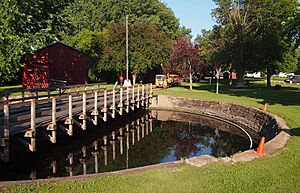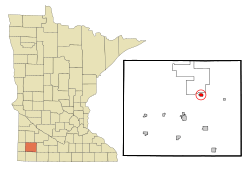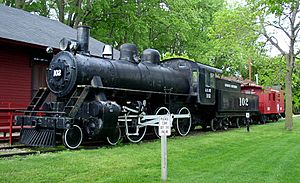Currie, Minnesota facts for kids
Quick facts for kids
Currie, Minnesota
|
|
|---|---|

Railway turntable at the End-O-Line Railroad Park and Museum in Currie, Minnesota
|
|
| Motto(s):
"Gateway to Lake Shetek"
|
|

Location in Murray County and the state of Minnesota
|
|
| Country | United States |
| State | Minnesota |
| County | Murray |
| Government | |
| • Type | Mayor – Council |
| Area | |
| • Total | 0.55 sq mi (1.43 km2) |
| • Land | 0.55 sq mi (1.43 km2) |
| • Water | 0.00 sq mi (0.00 km2) |
| Elevation | 1,503 ft (458 m) |
| Population
(2020)
|
|
| • Total | 224 |
| • Density | 407.27/sq mi (157.13/km2) |
| Time zone | UTC-6 (Central (CST)) |
| • Summer (DST) | UTC-5 (CDT) |
| ZIP code |
56123
|
| Area code(s) | 507 |
| FIPS code | 27-14320 |
| GNIS feature ID | 2393698 |
Currie is a small city in Murray County, Minnesota, United States. In 2020, about 224 people lived there. Currie is special because it's known as the "Gateway to Lake Shetek," which is the biggest lake in southwestern Minnesota. The city is also home to the End-O-Line Railroad Park and Museum, a fun place to visit. Lake Shetek State Park is also very close by.
Contents
History of Currie
Currie was started in 1872. It grew around a gristmill built by Neil and Archibald Currie. A gristmill is a building where grain is ground into flour. The city has had a post office since 1874, helping people send and receive mail.
Where is Currie Located?
Currie is in the northeastern part of Murray County. Minnesota State Highway 30 runs through the south side of the city. This highway connects Currie to other towns like Dovray and Slayton. Slayton is the main city for Murray County, called the county seat.
The Des Moines River starts about 1 mile (1.6 km) northwest of Currie, at Lake Shetek. It then flows through the northern part of Currie.
Currie's Population Over Time
| Historical population | |||
|---|---|---|---|
| Census | Pop. | %± | |
| 1880 | 78 | — | |
| 1910 | 329 | — | |
| 1920 | 405 | 23.1% | |
| 1930 | 435 | 7.4% | |
| 1940 | 524 | 20.5% | |
| 1950 | 551 | 5.2% | |
| 1960 | 438 | −20.5% | |
| 1970 | 368 | −16.0% | |
| 1980 | 359 | −2.4% | |
| 1990 | 303 | −15.6% | |
| 2000 | 225 | −25.7% | |
| 2010 | 233 | 3.6% | |
| 2020 | 224 | −3.9% | |
| U.S. Decennial Census | |||
In 2010, there were 233 people living in Currie. The city had 114 households. About 19.3% of these households had children under 18. The average age of people in Currie was 53.3 years old.
End-O-Line Railroad Park & Museum
The End-O-Line Park is located on the northern edge of Currie. It was founded in 1872. This area was seen as very beautiful, with the Des Moines River and Lake Shetek nearby. The park is close to Minnesota State Highway 30.
The Story of Railroads
The museum tells the story of how railroads helped the West grow. Railroads were a huge step forward in transportation. They changed how people and goods moved across the country.
Model Railroad Display
One of the best parts of the museum is a model railroad display. It's built in HO scale, which is a popular size for model trains. This display shows what the Currie railroad yards looked like around the year 1900. You can see tiny trains, buildings, and landscapes. It even has sound effects, so you can hear the steam engine chugging!
Sunrise Schoolhouse
The Sunrise School, also known as District Number One, was moved to End-O-Line Park. The Murray County Historical Society restored it. This one-room schoolhouse has cool features like tin ceilings and walls. It also has old world maps and a bell tower. It's a great way to see what school was like a long time ago.
Section House
The park also has a section house. This house was originally in Comfrey. It was built by the Chicago and North Western Transportation Company for a railroad foreman and his family. The house has been restored to look like it did in the early 1900s.
Fun Things to Do in Currie
Currie offers many outdoor activities for visitors.
Bike Trail
There is a 7-mile (11 km) bike trail. This trail goes through Lake Shetek State Park, around Lake Shetek, and past local farms. It's a great way to explore the area.
Lake Shetek
Just north of Currie is Lake Shetek. It's a very popular place for vacations, especially in the summer. Many people from southwestern Minnesota come here to enjoy the lake. During the summer, the population of the Currie/Lake Shetek area can reach almost 1,000 people!
See also
 In Spanish: Currie (Minnesota) para niños
In Spanish: Currie (Minnesota) para niños


